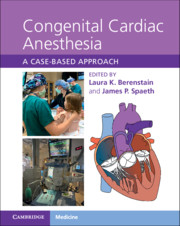Book contents
- Congenital Cardiac Anesthesia
- Congenital Cardiac Anesthesia
- Copyright page
- Dedication
- Contents
- Contributors
- Introduction
- Chapter 1 A Congenital Heart Disease Primer
- Section 1 Left-to-Right Shunts
- Section 2 Right-Sided Obstructive Lesions
- Chapter 6 Critical Pulmonic Stenosis
- Chapter 7 Tetralogy of Fallot
- Chapter 8 Repaired Tetralogy of Fallot
- Chapter 9 Tetralogy of Fallot with Absent Pulmonary Valve Syndrome
- Chapter 10 Tetralogy of Fallot, Pulmonary Atresia, and Aortopulmonary Collaterals
- Chapter 11 Pentalogy of Cantrell
- Chapter 12 Ebstein Anomaly
- Chapter 13 Ebstein Anomaly, Palliated
- Section 3 Left-Sided Obstructive Lesions
- Section 4 Complex Mixing Lesions
- Section 5 Single-Ventricle Physiology
- Section 6 Heart Failure, Mechanical Circulatory Support, and Transplantation
- Section 7 Miscellaneous Lesions and Syndromes
- Index
- References
Chapter 6 - Critical Pulmonic Stenosis
from Section 2 - Right-Sided Obstructive Lesions
Published online by Cambridge University Press: 09 September 2021
- Congenital Cardiac Anesthesia
- Congenital Cardiac Anesthesia
- Copyright page
- Dedication
- Contents
- Contributors
- Introduction
- Chapter 1 A Congenital Heart Disease Primer
- Section 1 Left-to-Right Shunts
- Section 2 Right-Sided Obstructive Lesions
- Chapter 6 Critical Pulmonic Stenosis
- Chapter 7 Tetralogy of Fallot
- Chapter 8 Repaired Tetralogy of Fallot
- Chapter 9 Tetralogy of Fallot with Absent Pulmonary Valve Syndrome
- Chapter 10 Tetralogy of Fallot, Pulmonary Atresia, and Aortopulmonary Collaterals
- Chapter 11 Pentalogy of Cantrell
- Chapter 12 Ebstein Anomaly
- Chapter 13 Ebstein Anomaly, Palliated
- Section 3 Left-Sided Obstructive Lesions
- Section 4 Complex Mixing Lesions
- Section 5 Single-Ventricle Physiology
- Section 6 Heart Failure, Mechanical Circulatory Support, and Transplantation
- Section 7 Miscellaneous Lesions and Syndromes
- Index
- References
Summary
During fetal development, little blood flows through the lungs due to high pulmonary vascular resistance. After birth, pulmonary vascular resistance is initially elevated and then decreases over the first few days of life. In normal infants the ductus arteriosus is not needed after birth and begins to functionally close during the first 24–72 hours after birth. It is anatomically closed between the third and fourth week of life. In infants with critical pulmonary valve stenosis, the amount of antegrade blood flow through the pulmonary valve to the pulmonary arteries is limited, and therefore the major source of source of pulmonary blood flow is provided via the ductus arteriosus. As it closes, if antegrade blood flow through the critically stenosed pulmonic valve is not sufficient infants become hypoxemic and may require institution of prostaglandin E1 to maintain ductal flow. Balloon pulmonary valvuloplasty in the cardiac catheterization laboratory is the treatment of choice for the typical dome-shaped valve characteristically seen in pulmonary stenosis. This chapter describes the perioperative considerations and management of an infant with critical pulmonary stenosis undergoing balloon valvuloplasty in the catheterization laboratory.
- Type
- Chapter
- Information
- Congenital Cardiac AnesthesiaA Case-based Approach, pp. 33 - 38Publisher: Cambridge University PressPrint publication year: 2021



